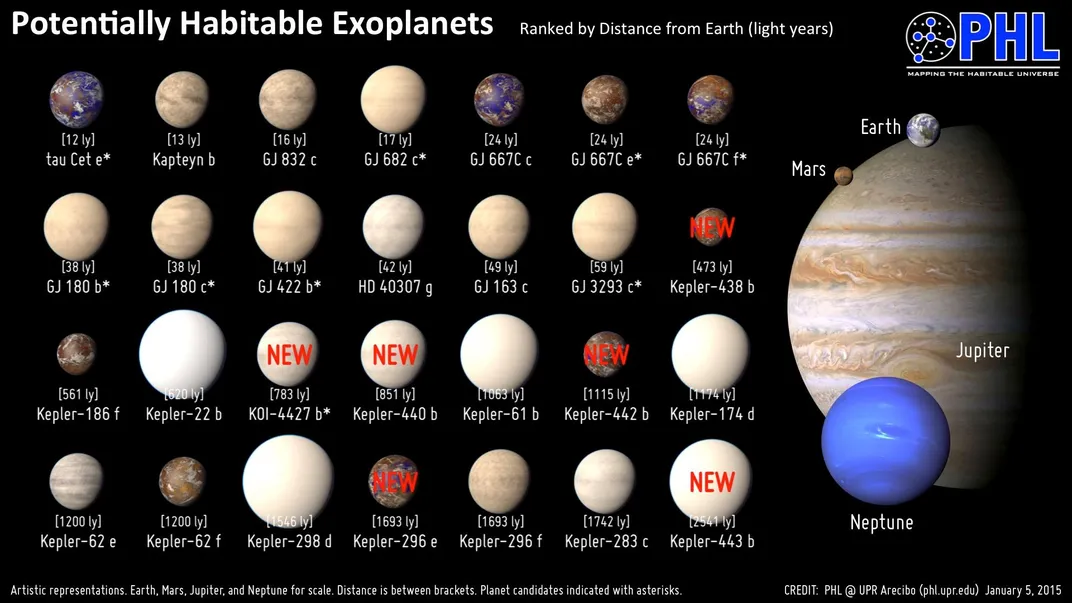Astronomers Just Doubled the Number of Potentially Habitable Planets
Another step closer to finding a second Earth
:focal(633x824:634x825)/https://tf-cmsv2-smithsonianmag-media.s3.amazonaws.com/filer/88/5e/885e47b6-7bc1-4287-a0db-7bbc787f2e99/cfa_new_planet.jpg)
A group of astronomers led by Guillermo Torres of the Harvard-Smithsonian Center for Astrophysics announced last week the discovery of more Earth-size planets located in the so-called habitable zone around their central stars. This significantly increases the number of potentially habitable exoplanets, which now stands at 28.
The new discoveries are based on data from NASA’s Kepler spacecraft, which has found more than 1,000 confirmed planets in the six years since it was launched, and is still operating, although in a reduced mode. Two of the twelve newly discovered exoplanets are of particular interest: Kepler-438b and Kepler-442b. According to the group’s estimates, the radius of Kepler-438b is only 12 percent larger than Earth’s radius, while Kepler-442b’s radius is about one-third larger than Earth’s. At that small size, they are likely to be rocky, terrestrial-like planets.
Kepler-438b receives 40 percent more light than Earth does, while Kepler-442b receives about two thirds as much. These estimates are also consistent with the idea that both planets are located in the habitable zone (defined as the region where liquid water would be stable on a planetary surface). Of course, even the presence of oceans on a planet doesn’t guarantee that there is life; it’s just one of the preconditions for biology as we know it. Life also requires organic compounds, a sheltering atmosphere, and probably also a nutrient-cycling mechanism like plate tectonics on Earth.
Given the great distance of these two newly discovered exoplanets from Earth (470 and 1,100 light years respectively), we won’t know about these other parameters anytime soon. Both worlds orbit a red dwarf star fainter than our Sun. Also called dM stars, red dwarfs are much more common than Sun-like stars in our galaxy, and are likely to provide suitable conditions for habitable planets.

Although the newly discovered planets are far away (typical for those discovered by Kepler), there are much closer potentially habitable exoplanets for which we may soon be able to collect more data. Four of them—the first four in the grouping above—are less than 20 light years away (although Kapteyn b is probably not habitable). Tau Ceti e, the closest potentially habitable exoplanet discovered to date and still unconfirmed, is 11.9 light years from Earth. But don’t expect mammals or birds there, either. According to some estimates, the average surface temperature on Tau Ceti e should be about 70o C, or 158o F.
So we’ll just have to stay patient. Life as we know it on our home planet, rich in biomass and biodiversity and some of it complex, may indeed be very rare and hard to find. Perhaps there are a lot of habitable worlds that aren’t inhabited. On the other hand, those planets might make suitable colonization target for future visitors from Earth.
/https://tf-cmsv2-smithsonianmag-media.s3.amazonaws.com/accounts/headshot/Dirk-Schulze-Makuch-headshot.jpg)
/https://tf-cmsv2-smithsonianmag-media.s3.amazonaws.com/accounts/headshot/Dirk-Schulze-Makuch-headshot.jpg)